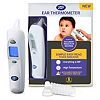Boots Pharmaceuticals Ear Thermometer
In order to buy non-prescription medicines you must be a registered user of our site as we are obliged to record your transaction history. We also ask that you complete our questionnaire so our pharmacy team can check that this product is suitable for you to buy.
Disabled or chronically sick people can claim VAT relief on purchases for personal or domestic use that are applicable to their disability or sickness.
Stock coming soon
This product is temporarily unavailable online. Use ‘Find in store’ below to see if it’s in stock near you.
 Product details
Product details
Boots Ear Thermometer
Accurate results within seconds
Simple easy read fever indicator with handy backlight for night time use
• Fever Alert
• Easy to use
• Backlight
• Stores last 10 readings
• Protective cap for hygiene
• C˚/F˚ measurement options
• Can also measure object and room temperature
This pack includes
• 1 x Boots Ear Thermometer
• 1 x Protective case
• 10 x Disposable caps
• 2 x 1.5v AAA batteries for operating thermometer
• 1 x Instruction Booklet
Why measure using an ear thermometer
Ear thermometers are widely used by healthcare professionals as a quick and easy, less intrusive alternative to a digital thermometer for measuring all but the very youngest children’s temperature. They provide accurate results without undue disturbance of the child, provided they are used correctly
Suitable for
From 6 months to adult
How to use
(For full details please read instruction manual enclosed)
Note: Remove plastic insulating strip from battery compartment before first use.
- Ensure a new protective cap is securely fitted over the thermometer tip before each use
- Switch the thermometer on, then pull the ear slightly up and backwards before gently inserting the thermometer tip into the ear and pressing the start button to begin the measurement.
- After approximately one second, an acoustic signal will sound and an easy read fever symbol plus the temperature will show in the display
- Once you have finished with the thermometer, switch off and return to protective case.
Hazards and Cautions
Temperature is not the only indication of illness. Consult a Doctor if you are concerned regarding your/your child's health, wether or not you have a high temperature.
Please read the instruction manual before use
Do not use outdoors or near any sources of heat
Do not drop thermometer or expose to any impacts
Important info
Frequently Asked Questions
1. Q. What is the “normal” temperature range and what temperature would be classed as a fever?
A. “Normal” body temperature varies between different people, different times of day and is affected by the level of activity prior to taking the reading.
There is no universally agreed “normal” temperature ranges. Depends on information source and site of measurement.
NHS indicates around 37°C for an adult (oral), around 36.4°C for a child (underarm)
Heathline.com indicates:
Babies and children - In babies and children, the average body temperature ranges from 36.6°C to 37.2°C.
Adults - Among adults, the average body temperature ranges from 36.1°C to 37.2°C.
Adults over age 65 - In older adults, the average body temperature is lower than 36.2°C.
Keep in mind that normal body temperature varies from person to person. Your body temperature might be up to 0.6°C higher or lower than the guidelines above. Identifying your own normal range can make it easier to know when you have a fever.
A fever is regarded as temperature above 37.8/38°C
Hypothermia is regarded as a temperature below 35°C
In addition to the temperature reading, the Ear Thermometer shows a “no fever” symbol at temperatures below 38°C and a “fever” symbol at temperatures of 38°C and over.
2. Q. What Factors affect “Normal” Body Temperature?
A. Many factors can influence body temperatures and include:
- A person’s individual metabolism
- Age (Body temperature is higher in babies and toddlers than in adults. Greater temperature fluctuations occur faster and more often in children. Normal body temperature decreases with age)
- Clothing
- Outside temperature
- Time of day (Body temperature is lower in the morning and increases throughout the day towards evening)
- Activities (Physical and, to a lesser extent, mental activities increase body temperature)
- Illness (A raised temperature is used by the body to fight illness)
- Some medications (e.g. antipyretics) may result in lower body temperatures
A. Switch off the Thermometer.
Ensure the thermometer has been at room temperature for at least 30 minutes.
Ensure ears are clean and free of earwax.
Ensure the tip of the Ear Thermometer is clean and undamaged
Ensure you have a new, clean cap on the thermometer.
Switch on the thermometer and wait for the display to switch on.
Gently pull the top of the ear slightly up and back and insert the thermometer cap; so that the tip is pointing directly at the eardrum and press the start button to take the measurement.
If the temperature recorded is still below “normal” levels and you feel unwell seek medical advice.
Note:
- Do not take temperature after exposure to very hot or very cold conditions or for 30 minutes after eating, drinking or exercising. Before taking temperature, sit/lie down for at least 5 minutes.
- You might get slightly different readings in the left and right ear; always use the same ear to monitor temperature.
- Do not use for Children under 6 Months.
- Do not use in ears affected by inflammatory disease or possible ear injuries.
- Wait 20 minutes before testing if ears have been covered, exposed to excessive heat/cold or after swimming/bathing.
A. Temperature is not the only sign of illness, if the patient feels unwell or there are other signs of illness such as agitation, severe sweating, flushed skin, fast pulse rate, tendency to collapse, even if the temperature recorded is “normal”; you should seek medical advice.
5. Q. How do I clean the thermometer for use by different people?
A. Always use a new cap for each measurement. Clean the thermometer body by wiping with a damp cloth (with soap or mild detergent). Wipe dry with a clean soft cloth. Always store the thermometer in the case provided to prevent damage to the tip. For detailed instructions on cleaning the tip – should this be required – carefully follow the instructions in the manual.
Note: if the thermometer has been used without a cap the reading could be inaccurate due to interference from wax build up. Follow the instructions in the manual carefully for cleaning the tip if required.
6. Q. The Thermometer indicates “Lo”, “Hi”, e.g. “ER1” or battery symbol when testing?
A. Refer troubleshooting guide (Section 11) in the instruction manual.
7. Q. Where can I purchase replacement caps?
A. Replacement caps are available in packs of 40 caps from Boots stores or Boots.com – item code 8053944.
For further information, please refer to the Instruction Manual supplied with the device and also available on the relevant product page on Boots.com








